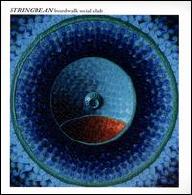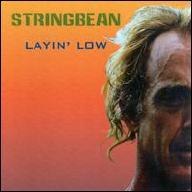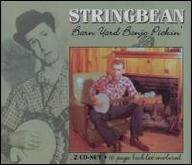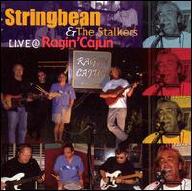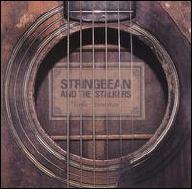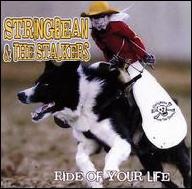Akeman was born to a farm family in Annville, in Jackson County, KY, and he became interested in music at an early age -- no surprise there, since not only did his father play the banjo at local dances, but he was surrounded by players of considerable skill in his local community, from all of whom he learned the banjo. He built his first homemade instrument at age seven out of a shoebox and thread borrowed from his mother, and by the time he was 12 he traded a pair of prize bantams he had raised for a real banjo. He was already making the rounds of local dances and developing a reputation on the instrument, but not earning a living. Akeman spent time working for the Depression-era Civilian Conservation Corps, building roads and planting trees.
Then he entered a talent contest that was being judged by singer-guitarist-musical saw player Asa Martin, and won. He joined Martin's band, and during one performance the bandleader stumbled over Akeman's name and, unable to remember it, introduced him to the crowd as "String Beans." With his tall, lanky frame, the name was a natural and it stuck.
At first, Akeman only played banjo in the group, but when another performer failed to turn up for a show, he was pressed into service as a singer and comic, and the act caught on. From that day forward, Akeman divided his time between comedy and music, along with some success as a semipro baseball player. He also broadcast on WLAP out of Lexington, KY, and played with various groups during the late '30s. At the time, the banjo had virtually disappeared from country music, and it was old-time players like Akeman who helped keep it alive.
Curiously enough, it was as a sandlot ballplayer -- and not a banjo player -- that Akeman first came to the attention of Monroe, who fielded a private semipro team. It wasn't too long before Monroe learned of Akeman's other talents, and in the early '40s David became a full-fledged member of Bill's group, where he remained from 1943 until 1945, playing on such recordings as Goodbye Old Pal. Akeman also spent some of his time during this period teamed with Willie Egbert Westbrook as "String Beans and Cousin Wilbur," a comedy duo, who often worked on the same bills with Monroe's outfit.
Akeman left Monroe in 1945 -- his replacement was Earl Scruggs, a banjo player with a radically different technique. That same year, he married Estelle Stanfill. During 1946, he first began working with Grandpa Jones (Louis Marshall Jones), a fellow old-time banjo player with a penchant for comedy. During the late '40s, Akeman also formed a team with Lew Childre and became a regular performer on the Grand Ole Opry. By this time, he'd adopted the costume by which he became best known to the public, a nightshirt and pants that made him look like a very tall man with very short legs. This kind of costume had many antecedents, including Slim Miller, a onetime stage comedian who was said to be Akeman's direct inspiration.
After the war, Akeman also became a protégé of Uncle Dave Macon, one of the biggest stars of the Grand Ole Opry. Macon, who died in 1952, was a banjo-player/comic and one of the Opry's most beloved performers. He took Akeman under his wing, telling him stories and jokes and playing him songs, and toward the end of his life he gave Akeman one of his own banjos.
Akeman was known by this time as Stringbean, and he was one of the Opry's top stars throughout the 1950s. Oddly enough, he didn't begin recording on his own until the early '60s, when he signed to the Starday label. By that time, Scruggs had emerged as the dominant figure in banjo playing, especially among younger listeners, but Akeman still had an audience for his older style of playing and his mixture of cornball comedy and song. He had hits with Chewing Gum and I Wonder Where Wanda Went and recorded seven albums between 1961 and 1972. The first of those albums, Old Time Pickin' Grinnin' with Stringbean (1961), was one of the best of these, representing his repertory of the era -- folk songs (especially humorous animal songs), tall stories, jokes -- although several of his subsequent albums are also worth hearing, most notably Salute to Uncle Dave Macon (1963) and Old Time Banjo Picking and Singing (1964). Akeman and Jones became the two biggest exponents of old-time banjo playing during this era.
Akeman remained a star of the Opry for the rest of his life, and in 1969 he and Jones became founding members of the cast of the television series #Hee Haw. He became an instant hit, his lanky figure and bewildered expression, coupled with self-deprecating one-liners, making Akeman one of the most popular members of the cast.
All of this ended tragically for Akeman and his wife, Estelle, on November 10, 1973. They returned home from a performance at the Opry and surprised a pair of burglars who shot the banjoman dead on the spot and pursued and killed his wife. It was Jones who found the bodies the next day, and the murders sent shock waves through the Nashville community. The subsequent capture and life sentences imposed on the killers -- two brothers -- did little to assuage the anger that Akeman's colleagues and friends felt. His memory lives on in the Monroe songs on which he played and the relative handful of his own recordings that have surfaced. ~ Bruce Eder, Rovi


